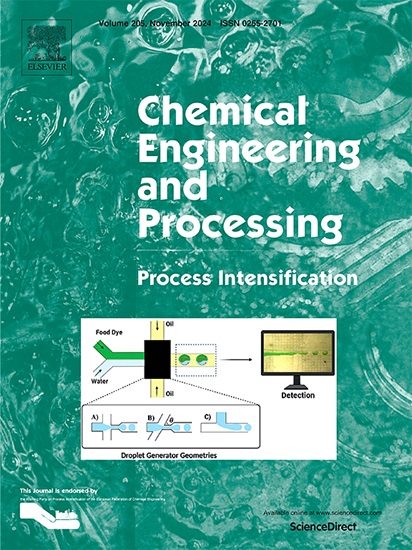载农药蒸馏残留物半焦微粒燃烧特性及污染物形成行为研究
IF 3.8
3区 工程技术
Q3 ENERGY & FUELS
Chemical Engineering and Processing - Process Intensification
Pub Date : 2025-04-05
DOI:10.1016/j.cep.2025.110305
引用次数: 0
摘要
为了有效地促进农药蒸馏残留物的资源化利用,本研究采用强剪切力将残留物与半焦微颗粒充分混合,保证其在微颗粒表面均匀分布。这种方法可以探索装载农药蒸馏残留物的半焦微粒的燃烧特性和污染物形成途径。结果表明,当升温速率为10℃/min时,随着农药残留比例的增加,着火温度降低;此外,随着升温速率的升高,点火温度和燃尽温度均升高。在污染物解离过程中,农药残渣中的吡啶环及其衍生物优先裂解CCl键生成氯自由基,而半焦中的碳碳三键等有机组分也发生裂解释放热量,导致吡啶环中的键断裂。这些解理产物与羟基自由基和氧自由基反应形成不饱和的有机化合物,如C4H4和C2H4,以及少量的氯、硫、氟、碳和氮化合物。随着氧浓度的增加,不饱和键被氧化。冷却后的主要产物是CO2、H2O、HCl、HF、NOx和COS。此外,半焦中的无机组分具有良好的固氟、固氯作用。本研究不仅揭示了载农药蒸馏残渣半焦颗粒的燃烧特性和污染物生成途径,而且预示了其在有机危险废物资源化利用领域的广阔应用前景。本文章由计算机程序翻译,如有差异,请以英文原文为准。

Study on the combustion characteristics and pollutant formation behavior of semi coke micro-particles loaded with pesticide distillation residues
To effectively promote the resource utilization of pesticide distillation residues, this study employs strong shear force to thoroughly mix the residues with semi-coke micro-particles, ensuring their uniform distribution on the surface of the microparticles. This approach allows for the exploration of the combustion characteristics and pollutant formation pathways of semi-coke micro-particles loaded with pesticide distillation residues. The results indicate that, when the heating rate is 10 °C/min, the ignition temperature decreases as the proportion of pesticide residue increases. Additionally, as the heating rate rises, both the ignition temperature and burnout temperature increase. During pollutant dissociation, the pyridine ring and its derivatives in the pesticide residue preferentially cleave the C![]() Cl bond to generate chlorine radicals, while organic components such as carbon-carbon triple bonds in the semi-coke also undergo cleavage and release heat, leading to the breakage of bonds in the pyridine ring. These cleavage products react with hydroxyl radicals and oxygen radicals to form unsaturated organic compounds such as C4H4 and C2H4, as well as small amounts of chlorine, sulfur, fluorine, carbon, and nitrogen compounds. As the oxygen concentration increases, the unsaturated bonds are oxidized. After cooling, the main products are CO2, H2O, HCl, HF, NOx, and COS. Furthermore, the inorganic components in the semi-coke exhibit good fluorine and chlorine fixation effects. This study not only reveals the combustion characteristics and pollutant generation pathways of the semi coke particles loaded with pesticide distillation residues, but also foretells its broad application prospects in the field of organic hazardous waste resource utilisation.
Cl bond to generate chlorine radicals, while organic components such as carbon-carbon triple bonds in the semi-coke also undergo cleavage and release heat, leading to the breakage of bonds in the pyridine ring. These cleavage products react with hydroxyl radicals and oxygen radicals to form unsaturated organic compounds such as C4H4 and C2H4, as well as small amounts of chlorine, sulfur, fluorine, carbon, and nitrogen compounds. As the oxygen concentration increases, the unsaturated bonds are oxidized. After cooling, the main products are CO2, H2O, HCl, HF, NOx, and COS. Furthermore, the inorganic components in the semi-coke exhibit good fluorine and chlorine fixation effects. This study not only reveals the combustion characteristics and pollutant generation pathways of the semi coke particles loaded with pesticide distillation residues, but also foretells its broad application prospects in the field of organic hazardous waste resource utilisation.
求助全文
通过发布文献求助,成功后即可免费获取论文全文。
去求助
来源期刊
CiteScore
7.80
自引率
9.30%
发文量
408
审稿时长
49 days
期刊介绍:
Chemical Engineering and Processing: Process Intensification is intended for practicing researchers in industry and academia, working in the field of Process Engineering and related to the subject of Process Intensification.Articles published in the Journal demonstrate how novel discoveries, developments and theories in the field of Process Engineering and in particular Process Intensification may be used for analysis and design of innovative equipment and processing methods with substantially improved sustainability, efficiency and environmental performance.

 求助内容:
求助内容: 应助结果提醒方式:
应助结果提醒方式:


